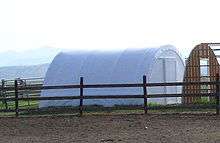Tension fabric building
Tension fabric buildings are constructed using a rigid frame—which can consist of timber, steel, rigid plastic, or aluminum—and a sturdy fabric outer membrane. Once the frame is erected, the fabric cover is stretched over the frame. The fabric cover is tensioned to provide the stable structural support of the building. The fabric is tensioned using multiple methods, varying by manufacturer, to create a tight fitting cover membrane.

Compared to traditional or conventional buildings, tension fabric buildings may have lower operational costs due the daylight that comes through the fabric roof when light-coloured fabrics are used. This natural lighting process is known as daylighting and can improve both energy use and life-cycle costs, as well as occupant health.[1][2]
Tension fabric structures may be more quickly installed than traditional structures as they use fewer materials and therefore usually require less ground works to install.[3][4]
Some tension fabric structures, particularly those with aluminium frames, may be easily relocated.
Common applications
Tension fabric buildings have gained popularity over the last few decades in many industries including the following applications: sports facilities, commercial structures, industrial buildings, manufacturing, warehousing, sand and salt storage for road maintenance departments, environmental management, aviation, airplane hangars, marine, government, military, remediation and emergency shelters, hay and feed storage, and horse riding arenas. [3][5]
In addition, these structures are also suitable to quickly expand existing facilities, just attaching these fabric structures as extension for warehouses or workspaces. They can also be used as covered loading/unloading areas.[6]
Tension fabric buildings are often used for sport due to the natural light that permeates light-coloured fabrics. These buildings provide covered indoor spaces that allow teams to train in natural light conditions when weather is inclement, combating a common problem in sports known as rainout.
The lightweight properties of the fabric roofs enables the construction of tension fabric structures up to 100 meters clear span without supporting pillars or columns, contributing to the use of these buildings for applications that require large open spaces. One example is Phase 2 of the Sport Ireland National Indoor Arena project which includes a tension fabric building that will be 18,480m2 in size, to be used for gaelic games, rugby and soccer.[7][8]
These buildings may also be used for holding livestock or as indoor riding arenas, due to the controlled interior climate and the existence of tension structures that run over one mile long.[9]
Construction
Building sizes are usually standardized by the nature of being a pre-engineered building. Some manufacturers produce tension fabric buildings spanning up to 300 feet wide and to almost any length. Buildings can be designed to be portable, mounted on wheels or other rolling crane-type designs fitted to the base-plates, or lifting in modules by overhead cranes.
Industrial strength fabric, some of which can have life expectancies of 20–30 years, have been used for many applications. Fabric's life expectancy is affected by local environmental factors (e.g. sunlight, temperature, wind, air quality) and occupancy conditions (e.g. humidity, chemical vapours). The current structural membranes available are made of PVC or polyethylene. Some fabrics are sufficiently translucent to allow sunlight to pass through, creating a naturally lit environment inside the building. Fabric selection influences project capital cost and maintenance.
Building regulation
In some jurisdictions tension fabric buildings may qualify as temporary structures which benefit from a shorter capital depreciation period, relative to a permanent structure, for tax purposes. Buildings classified as temporary structures may have significant limitations on occupancy, applied load and fire safety considerations and period of installation.
Whilst a common application of tension fabric buildings is for temporary use, they are not exempt from regulatory requirements including compliance with building codes, occupancy classifications, aesthetics and building permits. Fabric tension buildings are required to meet the same Building Code safety requirements and applicable design standards as any other structure.
Tension fabric buildings may also be permanent structures and structural longevity will vary according to manufacturer.
References
- Szybinska, Barbara Szybinska (2017). "Daylighting is More than an Energy Saving Issue". Energy Efficient Buildings. doi:10.5772/65866. ISBN 978-953-51-2875-5.
- Boubekri, Mohamed (2008). Daylighting, architecture and health : building design strategies. Architectural. ISBN 978-0-7506-6724-1.
- plc, Collinson. "Tensile Fabric Structures: The Ultimate Guide (New For 2018)". info.collinson.co.uk. Retrieved 2018-07-02.
- Collinson. "10 Advantages Of Tensile Fabric Structures". Retrieved 2018-07-02.
- https://allsitestructures.com/clear-span-fabric-structures/
- https://chapiteaux.online/en/fabric-structures-expanding-existing-warehouses/
- David, Gash. "Minister Ross Announces Commencement of Phase Two of Sport Ireland National Indoor Arena". www.sportireland.ie. Retrieved 2018-07-02.
- "Irish Rugby". irishrugby.ie. Retrieved 2018-07-02.
- "Archived copy". Archived from the original on 2014-03-26. Retrieved 2014-03-26.CS1 maint: archived copy as title (link)
External links
- The History of Tension Fabric Structures
- Fabric Buildings for Oil & Gas Exploration
- Son, Miriam Euni (2007). The design and analysis of tension fabric structures (Thesis). Massachusetts Institute of Technology. hdl:1721.1/39275.
- Fabric Structures Association